The process of constructing and maintaining pipelines is very complex. Throughout their lifetimes, pipelines require a multitude of surveys to guarantee their integrity. These various types of surveys are used to protect against common pipeline failures such as leaks, and they also work proactively to prevent disasters such as pipeline bursts.
Pipeline surveys, no matter which type, are instrumental in protecting both human and wildlife populations within the range of pipelines. With the data collected through surveying, pipelines can be engineered in a way that minimizes environmental damage.
Out-of-straightness (OOS) surveys are conducted specifically on offshore pipelines, also known as underwater pipelines. Just as other surveys do, they are intended to ensure the pipeline’s integrity after construction is complete. This article aims to detail the importance of out-of-straightness surveys, when they are used, and how their use may benefit any pipeline.
What is a Pipeline Out of Straightness Survey?
In pipeline maintenance, out-of-straightness refers to non-manmade curves or bends. An out of straightness survey is able to locate and measure bends, indicating where possible failure points may be located.
Out-of-straightness surveys are almost always conducted on offshore pipelines. These pipelines tend to be almost completely straight due to the lack of natural obstacles underwater. But there are bends that occur, and that’s where OOS surveying comes into play.
These pipelines can be bent, however, by natural features. Thermal expansion can cause a pipe to distort its shape in operation, creating interior pressure. Other factors, such as seabed movement, can bend and weaken the pipe.
If left unattended, these forces can cause the pipe to collapse, preventing precious materials such as oil or gas from flowing. Billions of people around the world rely on pipelines to provide them with critical energy. A collapse of a pipe due to a bend can cause a crisis, leaving many without power and resulting in losses for the pipeline company.
Even worse, an accidental bend can strain a pipe, causing it to burst. The environmental damage caused by such an event can be cataclysmic, destroying the surrounding ecosystem and incurring millions of dollars in clean-up costs for the company behind the pipeline.
Instead of waiting for disaster to strike, OOS surveys and identifies possible problems proactively. This allows engineers time to find long-term solutions for bending and prevents the environmental and human consequences that we have discussed above.
What is the Process of a Pipeline Out of Straightness Survey?
The technology associated with OOS surveys is constantly progressing. Remotely operated vehicles and autonomous underwater vehicles are able to collect data on pipelines without a human driver, sending it back to their control centers in real-time. The use of these vehicles makes the process of OOS surveying both safer and more accurate.
These vehicles are able to traverse the outside of the pipeline, using their sonar systems to profile the entire line. This information is then compiled by an experienced surveyor who is able to pinpoint possible weak spots along the pipeline.
Other tools, such as Inertial Measurement Units (IMUs), are able to survey the interior of the line. IMUs are sent inside the line, collecting data at every point. They are often more cost-effective than other surveying methods and can provide significant insight during the survey process.
No tool is perfectly suited when it comes to any survey. Oftentimes, surveyors will use a multitude of tools and techniques to garner the best results. When looking to conduct your OOS survey, it is critical to invest in experienced and innovative surveyors.
After the initial data is collected, specialists such as engineers and geologists analyze the data to find possible weak spots along the line. Weak spots may be points where a slight bend prevents the flow of oil or strains the pipe. Then a report is compiled with all the information from the survey in a digestible format.
Finally, the report is presented to the oil operating company. Both the surveying team and the pipeline operating company must work closely with one another to find possible solutions in the case of bending or unexpected curves.
How Long Does a Pipeline Out of Straightness Survey Generally Take?
The initial time it takes to collect data for the survey, using the tools mentioned above, may be brief. This stage may take anywhere from a few days to a few weeks. But even though the initial data collection process can be quick, it’s important to account for additional time to compile and analyze data.
This second phase of the pipeline out of straightness survey project can take a significant amount of time. To make any meaning out of the complex data points that have been collected, a team of surveyors must make a robust and comprehensive report. This process may take anywhere from a few weeks to a few months, depending on the size of the project.
Then, those findings have to be analyzed and discussed with all stakeholders involved in the pipeline process. This can include the pipeline company, investors, project managers, engineering firms, federal and state regulatory agencies, and others.
It’s important that the survey findings are presented in a digestible format so all individuals can be kept in the loop.
Are Pipeline Out of Straightness Surveys Required?
Because OOS surveys are so critical to maintaining a pipeline’s integrity and ongoing safety, many governments require that pipeline companies employ them. In the United States, there are state and federal guidelines relevant to OOS surveys.
Even when not required by the government, nearly all pipeline companies routinely conduct OOS surveys. These surveys build on one another, creating a map of how a pipeline may shift over time for future reference. Plus, OOS surveys can cover a company’s bases in the future, showing due diligence in case of an unexpected accident such as a leak or burst pipeline.
When a company works with an experienced and thorough surveying company or engineering firm, an OOS survey will often be part of the post-construction pipeline work that will be performed.
More often than not, it’s a worthwhile investment to ensure that the pipeline doesn’t succumb to leaks, spills, or other incidents that could harm the company’s reputation – and, of course, the bottom line.
Why Are Pipeline Out of Straightness Surveys Useful?
Pipeline OOS surveys are the quickest and most cost-effective way to detect even the smallest bend or strain in a given pipeline. They are routinely used when conducting underwater pipeline maintenance, and are conducted post-construction.
The information collected during these surveys is not only useful to that specific pipeline but to future pipeline projects as well. OOS surveys compile data on seabed movement that can be useful when planning a new pipeline in that region.
Identifying bends in the pipeline can help increase pipeline efficiency. Even the smallest bend can reduce the amount of flow possible in a pipeline. By finding and rectifying this issue, pipeline companies can ensure they are operating at maximum efficiency.
More recent innovations, such as autonomous underwater vehicles (AUVs), are able to accelerate the process, all while eliminating the risk of human error. These unmanned, untethered rovers can survey the length of the pipeline automatically, sending back information in real-time to surveyors above ground.
AUVs are just one example of an emerging technology in the oil and gas industry. In the future the industry will likely include more and more automated technologies as it shifts towards using more renewable energy sources, coupled with more stringent environmental regulations.
With these changes, OOS surveys will only become more practical as new technologies make the process even easier.
Who is Involved in Pipeline Out of Straightness Surveys?
There are many people involved when it comes to conducting a pipeline survey. Most often, pipeline operating companies subcontract this job out and hire an organization that specializes in surveying to ensure reliable results.
These surveyors are responsible for planning and executing the survey. When conducting underwater surveys, they will monitor the pipeline’s curvature using AUVs or other technology that is available and effective to collect accurate data.
Engineers specializing in pipelines are often responsible for analyzing the survey data and compiling this raw data into a report for the pipeline company. They may find and catalog weak points along the pipeline so that all stakeholders can have an accurate, digestible picture of what’s going on with the project.
Regulatory authorities may also have a part in overseeing a pipeline OOS survey. Often, out of straightness surveys are completed in compliance with government bodies, as they are one of the best ways to ensure the integrity of a pipeline.
The relationship between environmental surveying companies and the pipeline companies that hire them must be a collaborative one. A good environmental surveying team will communicate with the pipeline company at every stage of the process, as there may be specific weak points along the pipeline that must be carefully monitored.
Without a collaborative relationship between the stakeholders involved in a pipeline OOS survey, the project may not be very useful. When choosing an environmental surveying agency, it must be one you can trust and one that has an experienced and dedicated team.
FAQs
What is out of straightness in an oil pipeline?
Out of straightness in the oil and gas industry refers to any non-manmade curve in the length of a pipeline. Many underwater pipelines are straight due to the lack of underwater obstacles. Any unplanned curve in an otherwise straight pipeline can be dangerous.
What is OOS surveying?
OOS surveying is the process of monitoring the straightness of an underwater pipeline. Although these surveys used to require underwater divers, they can now be accomplished with the use of automated technologies such as autonomous underwater vehicles (AUVs).
Some technologies are able to navigate the outside of the pipeline, while others traverse the inside. Nearly every OOS surveying project employs the use of multiple technologies to get the full picture of the pipeline’s curvature, both planned and unplanned.
How do you measure pipe straightness?
Rovers and automated devices are able to collect important data including seabed movement and crossings of internal infrastructure, which are possible indicators of bending in the line.
Innovations in geospatial imaging allow surveyors to make a comprehensive map of a pipeline that they can refer back to over time. Using these tools, teams of surveyors are better able to track the shifting of pipelines over time.
Final Thoughts
Pipeline out of straightness surveys are the best way to maintain the integrity of pipelines, an essential measure in protecting the surrounding environment from harm. These surveys are also part of an ongoing effort to preserve natural ecosystems by mitigating pipeline-related risks to both humans and the environment.
However, conducting an OOS survey can be an intensive process. A skilled and experienced team is necessary to guarantee reliable results. We here at Fenstermaker are just that, adapting our specialized environmental knowledge to any pipeline project.








